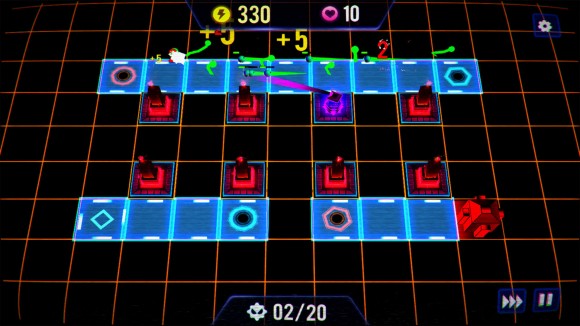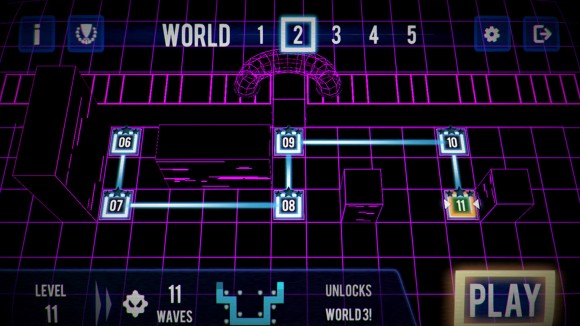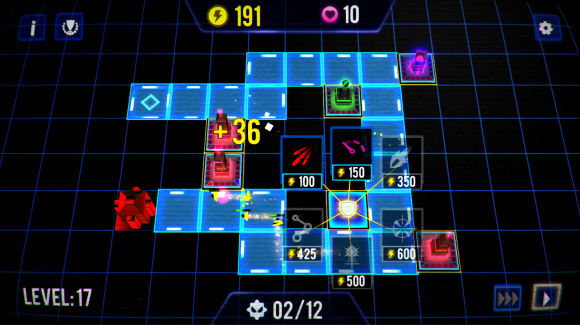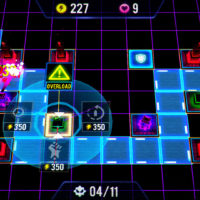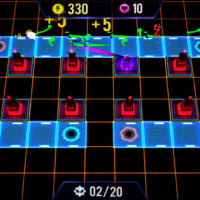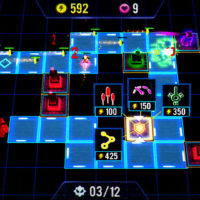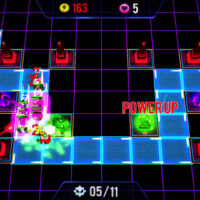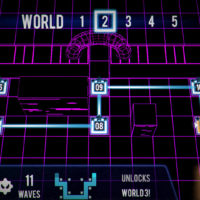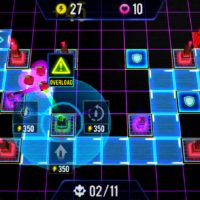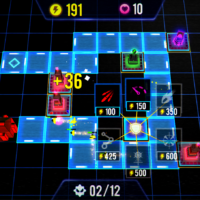Game: “Defentron”
Defentron

Ah, the 1980s. It was a time of arcade machines, bright lights, and saying “radical dude” to everything. OK, I’ll admit my knowledge of the eighties is entirely based on the Teenage Mutant Hero Turtles. Nevertheless, the fact remains that when people talk about this era there’s always big hair, neon lights, and computer graphics that involve chunky hardware and backgrounds based on graph paper. Enter: Defentron, a tower defence game set in the 80s with graph paper backgrounds and neon lights. We’re not sure on the big hair part, but if there were people in this game, they’d have huge hair for sure!
At A Glance
| Visuals | 5 / 10 |
| Sound | 7 / 10 |
| Gameplay | 5 / 10 |
| Overall | 6 / 10 |
| Positives | + Nice backgrounds & techno music
+ Ability to pause each wave you need to + Quick restarts between levels |
| Negatives | – Basic levels
– Limited enemy and tower design – Console controls are fiddly |
Developed by Planetfall Studios and published by Zerouno Games, Defentron throws you into a PC that must defend itself from the onslaught of viruses. Set to a thumping techno soundtrack, you start by plonking down a variety of towers to help stop the waves of enemies. It’s pretty straightforward to begin with, with a bog-standard shooting tower, but you soon unlock more useful weapons as the levels progress. During each mission, you can upgrade the range, power and speed of each weapon by harvesting energy from destroyed viruses, there’s even a self-destruct button for each tower. This comes in handy when the waves of viruses ramp up through the course of a level.
The spaces you can place your towers in and the route the viruses travel is predetermined which means you can just plonk your artillery on the board and watch the action unfold. I felt having predetermined spots was both useful and restrictive; I could easily determine my strategy with what towers to put where but when I failed a level, there were limited options on how to improve my strategy. Aside from changing up what towers you pop down and which upgrades to apply, there’s very little else you can do.
Defentron has a control setup that would be more suited to a *whispers* mobile game. You can use your controllers to navigate to each tower, and a button press will bring up the menu – from there it’s a simple click of the ‘upgrade’ option and a click again to confirm. It’s pretty time consuming, and when facing down hundreds of enemies, not particularly practical. I found that having the console in handheld mode allowed you to make use of the console’s touchscreen. This allowed much quicker access to menus as tapping the tower brought your upgrade options, then tapping the one you wanted confirmed the action. It’s nice and simple and worked better than using a controller.
I mention the controls as having fewer obstructions during each wave is vital. Even early on in the game, you are constantly bombarded. Thankfully, a press of the X button (or tap of the screen), you can pause the game mid-wave. This gives you the time to sort your life out. There’s also a fast-forward button which, as I’m sure you can guess, speeds things up. A lot. This fast forward button is effectively a ‘suicide button’ in later levels. It’s as if the team at Planetfall thought about making the game easy, said, “nah” and proceeded to annihilate my progress, on more than one occasion. Touché. Below is a snippet of what happened to me clicking said speed up button during a big wave. *Spoiler Alert* it doesn’t go well.
The video also shows off another pretty cool feature. When you let enemies through your defence, it looks like the game’s framerate begins to struggle; let too many through and viruses start to jump about erratically. I thought, ’a game that’s not very taxing hardware-wise, shouldn’t struggle’ – it didn’t seem right. It took me a minute, but I then realised that it was to reflect that the in-game PC was too infected to cope rather than your actual console – it’s a nice touch. (I mean, if it’s not intentional then the in-PC setting is a great cover up from a development point of view.)
Overall, Defentron is a good entry point if you’ve not played many games in this genre. The neon stylings of the game, and the techno background music really adds to the feel of the game. The learning curve lulls you into a false sense of security at times and ramps up considerably. The levels can be stupidly frustrating and unfair, but if you’re determined enough, there’s a genuine celebration when you complete that level you’ve attempted nearly 100 times over.
Thankfully, Defentron is more of a mobile game in that the levels are short and compact, and restarting is quick and easy. However, because towers can be only placed in certain places, the path of each level is fixed, and the viruses travel in the same routes each time, Defentron becomes more a game of trial and error, mixed with a touch of luck rather than a pure strategy game.
In the interest of full disclosure, the publisher provided VGamingNews with a copy of the game in order to conduct this review.


